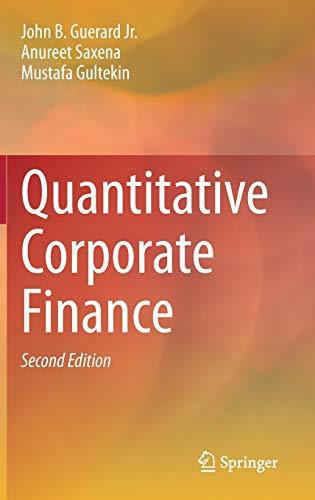Answered step by step
Verified Expert Solution
Question
1 Approved Answer
Question B please The expected return from investing in a security over some future holding period is an estimate of the future outcome of this

Question B please
The expected return from investing in a security over some future holding period is an estimate of the future outcome of this security. Risk is an important concept in financial analysis, especially in terms of how it affects security prices and rates of return. Investment risk is associated with the probability of low or negative future returns. The riskiness of an asset can be considered in two ways: (1) on a stand-alone basis, where the asset's cash flows are analyzed all by themselves, or (2) in a portfolio context, where the cash flows from a number of assets are combined and then the consolidated cash flows are analyzed. In a portfolio context, an asset's risk can be divided into two components: (1) a diversifiable risk component, which can be diversified away and hence is of little concern to diversified investors, and (2) a market risk component, which reflects the risk of a general stock market decline and which cannot be eliminated by diversification, hence does concem investors. Only market risk is relevant, diversifiable risk is irrelevant to most investors because it can be eliminated Portfolio manager is expected to form a portfolio of stocks and bonds and other assets that provide the highest possible rate of return at the lowest possible level of risk. In other words, to form a portfolio that allocates funds in different assets in such a way that the portfolio is well diversified and provides the highest return at the lowest possible risk. Using monthly stock prices of 20 companies in listed in Bursa Malaysia (with the time span of at least three years), select the top 10 companies with the highest risk adjusted return and make an equally weighted portfolio of the 10 companies. Required: a) Provide a brief introduction and a description on the methodology which are used in calculating risk and return for the individual asset and portfolio. (40 marks) b) Calculate the risk and the return on the individual asset. (30 marks) c) Calculate the risk and the return on the portfolio The expected return from investing in a security over some future holding period is an estimate of the future outcome of this security. Risk is an important concept in financial analysis, especially in terms of how it affects security prices and rates of return. Investment risk is associated with the probability of low or negative future returns. The riskiness of an asset can be considered in two ways: (1) on a stand-alone basis, where the asset's cash flows are analyzed all by themselves, or (2) in a portfolio context, where the cash flows from a number of assets are combined and then the consolidated cash flows are analyzed. In a portfolio context, an asset's risk can be divided into two components: (1) a diversifiable risk component, which can be diversified away and hence is of little concern to diversified investors, and (2) a market risk component, which reflects the risk of a general stock market decline and which cannot be eliminated by diversification, hence does concem investors. Only market risk is relevant, diversifiable risk is irrelevant to most investors because it can be eliminated Portfolio manager is expected to form a portfolio of stocks and bonds and other assets that provide the highest possible rate of return at the lowest possible level of risk. In other words, to form a portfolio that allocates funds in different assets in such a way that the portfolio is well diversified and provides the highest return at the lowest possible risk. Using monthly stock prices of 20 companies in listed in Bursa Malaysia (with the time span of at least three years), select the top 10 companies with the highest risk adjusted return and make an equally weighted portfolio of the 10 companies. Required: a) Provide a brief introduction and a description on the methodology which are used in calculating risk and return for the individual asset and portfolio. (40 marks) b) Calculate the risk and the return on the individual asset. (30 marks) c) Calculate the risk and the return on the portfolioStep by Step Solution
There are 3 Steps involved in it
Step: 1

Get Instant Access to Expert-Tailored Solutions
See step-by-step solutions with expert insights and AI powered tools for academic success
Step: 2

Step: 3

Ace Your Homework with AI
Get the answers you need in no time with our AI-driven, step-by-step assistance
Get Started


